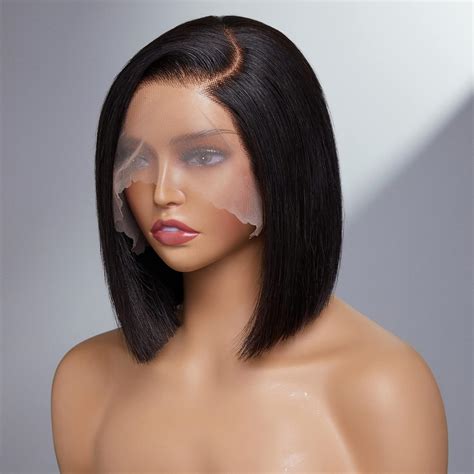Introduction
In today’s beauty-obsessed world, wigs have become an indispensable tool for anyone looking to transform their appearance. From celebrities to everyday fashionistas, wigs are empowering people to express themselves uniquely and confidently. This comprehensive guide will delve into everything you need to know about wigs, exploring their types, benefits, maintenance, and beyond.

Types of Wigs
1. Lace Front Wigs
Lace front wigs feature a realistic hairline made of thin lace that blends seamlessly with your skin tone. They offer the most natural look and can be styled in various ways.
2. Full Lace Wigs
Full lace wigs provide the ultimate versatility, as they can be parted anywhere on the scalp. They are more breathable and comfortable than other types of wigs.
3. Synthetic Wigs
Synthetic wigs are made from man-made fibers, making them more budget-friendly than human hair wigs. They come in a wide range of colors, styles, and lengths.
4. Human Hair Wigs
Human hair wigs offer the most natural look and feel. They are more expensive than synthetic wigs but provide superior longevity and styling options.
Benefits of Wearing Wigs
1. Instant Hair Transformation
Wigs allow you to change your hair color, length, and style instantly, giving you the flexibility to experiment with different looks without damaging your natural hair.
2. Hair Loss Solution
For those experiencing hair loss due to medical conditions or genetic factors, wigs offer a discreet and stylish way to conceal hair thinning or baldness.
3. Confidence Boost
Wearing a well-fitted wig can boost your confidence and self-esteem by enhancing your appearance and allowing you to feel more attractive.
4. Hair Protection
Wigs can protect your natural hair from heat damage caused by styling tools and environmental factors such as sun exposure and pollution.
How to Choose the Right Wig
1. Determine Your Head Size
Measure the circumference of your head to determine your correct wig size. This will ensure a snug fit that prevents slipping or discomfort.
2. Decide on a Hair Type
Consider your budget, lifestyle, and desired look when choosing between synthetic or human hair wigs. Human hair wigs provide a more natural look but require more care.
3. Select a Style
Choose a wig style that complements your face shape and personal preferences. Experiment with different lengths, textures, and colors until you find one that suits you best.
Wig Maintenance
1. Regular Washing
Wash your wig every 3-5 wears or as needed. Use a sulfate-free shampoo specifically designed for synthetic or human hair wigs.
2. Conditioning
Condition your wig after each wash to keep it soft and manageable. Use a conditioner designed for the type of hair your wig is made of.
3. Drying
Allow your wig to air dry naturally or use a low heat setting on a hairdryer. Avoid rubbing or twisting the wig while wet, as this can cause tangles.
Common Mistakes to Avoid
1. Wearing a Wig That’s Too Tight
A tight wig can cause headaches and discomfort. Choose a wig that fits your head size comfortably.
2. Over-Styling
Excessive heat styling can damage your wig. Use heat protectants and minimize the use of styling tools.
3. Not Cleaning Your Wig Regularly
Dirty wigs can become matted and unhygienic. Wash your wig regularly to keep it clean and fresh.
Tips and Tricks
1. Customize Your Wig
Don’t be afraid to cut, trim, or style your wig to create a look that’s uniquely yours.
2. Invest in a Wig Stand
Store your wig on a wig stand to maintain its shape and prevent tangles.
3. Use Wig Caps
Wig caps create a barrier between your scalp and the wig, protecting your natural hair and reducing friction.
4. Travel with Your Wig
Pack your wig in a designated wig case when traveling to keep it protected.
The Wig Market: A Growing Industry
According to the market research firm Mordor Intelligence, the global wig market is projected to reach $10.48 billion by 2028. This growth is attributed to the increasing demand for wigs for both cosmetic and medical purposes.
Wigs in Pop Culture
Wigs have played a significant role in popular culture throughout history. From the iconic wigs worn by Cleopatra and Marie Antoinette to the modern wigs used in films and TV shows, wigs have shaped fashion and influenced societal norms.
Innovation in the Wig Industry
1. Smart Wigs
Smart wigs combine technology with hair fashion. They incorporate sensors that can detect scalp temperature and adjust ventilation accordingly, providing increased comfort.
2. 3D-Printed Wigs
3D printing technology allows for the creation of custom-fit wigs tailored to the wearer’s unique head shape and hair texture.
3. Wig-Verse
The “wig-verse” is a new term coined to describe the emerging trend of wig-related social media platforms and communities. These platforms connect wig enthusiasts, provide styling advice, and showcase the latest wig trends.
Conclusion
Wigs have come a long way from their humble beginnings. Today, they are an essential part of the beauty industry, empowering people to transform their appearance and express themselves through a wide range of styles and colors. From lace front wigs to full lace wigs, human hair wigs to synthetic wigs, there is a wig out there to suit every taste, need, and budget. Whether you’re looking to enhance your natural look, conceal hair loss, or simply have some fun with different hairstyles, wigs offer a boundless realm of possibilities. Embrace the transformative power of wigs and let your creativity shine through.
